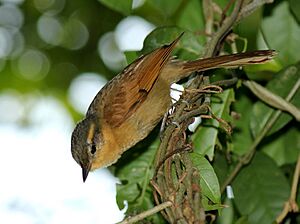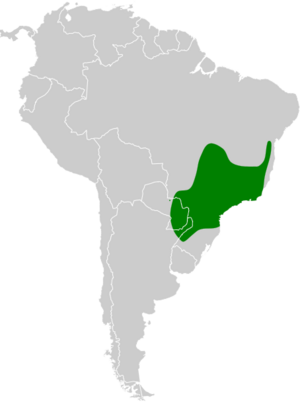Ochre-breasted foliage-gleaner facts for kids
Quick facts for kids Ochre-breasted foliage-gleaner |
|
|---|---|
 |
|
| At São Sebastião, São Paulo, Brazil | |
| Conservation status | |
| Scientific classification | |
| Genus: |
Anabacerthia
|
| Species: |
lichtensteini
|
 |
|
| Synonyms | |
|
Philydor lichtensteini |
|
The ochre-breasted foliage-gleaner is a small bird. Its scientific name is Anabacerthia lichtensteini. This bird belongs to the ovenbird family, called Furnariidae. You can find it in countries like Argentina, Brazil, and Paraguay.
Contents
About the Ochre-breasted Foliage-Gleaner
How Scientists Classify This Bird
Scientists first thought the ochre-breasted foliage-gleaner belonged to a different group of birds called Philydor. But in 2011, new research showed it was actually part of the Anabacerthia group. This research also found that it is closely related to the white-browed foliage-gleaner. They are like 'sister species'.
This bird is also 'monotypic'. This means there are no different subspecies or types of the ochre-breasted foliage-gleaner.
What This Bird Looks Like
The ochre-breasted foliage-gleaner is about 15 to 17 centimeters (6 to 7 inches) long. It weighs between 18 and 24 grams (0.6 to 0.8 ounces). It is a medium-sized bird with a short, wedge-shaped beak. Both male and female birds look the same.
Adult birds have a bright yellow-orange ring around their eyes. They also have a clear, pale stripe above their eyes, called a supercilium. There's a dark brown band behind their eye. Their ear feathers are a dull reddish-orange, and the area near their beak is pale brownish.
The top of their head is dull gray-brown with faint lighter stripes. Their back is reddish-brown, and their rump and upper tail feathers are a bit lighter reddish-brown. Their tail is mostly reddish, with reddish-brown outer edges on the inner feathers. Their wings are reddish-brown, with darker tips on the flight feathers.
Their throat and cheek area are bright yellow-orange. Their upper chest is a richer yellow-orange, and the rest of their belly is a duller yellow-orange. Their eyes are brown. Their upper beak is brownish-gray, and their lower beak is light gray. Their legs and feet are greenish-gray. Young birds have less even colors on their bellies, and those feathers have grayish tips.
Where This Bird Lives
The ochre-breasted foliage-gleaner lives in southeastern Brazil. You can find it from the states of Bahia, Goiás, and Mato Grosso do Sul all the way south to Rio Grande do Sul. It also lives in eastern Paraguay and in northeastern Argentina's Misiones Province.
This bird prefers to live in mountain evergreen forests. It also likes tall secondary forests, which are forests that have grown back after being cut down. It can be found from sea level up to about 800 meters (2,600 feet) high.
Behavior and Life Cycle
Movement and Migration
The ochre-breasted foliage-gleaner stays in the same area all year round. It does not migrate.
What This Bird Eats
This bird eats arthropods, which are creatures like insects and spiders. It usually hunts for food with other bird species in mixed flocks. It typically searches for food from the middle to the top of the forest trees. It moves around skillfully, picking and pulling its prey from dead leaves, bits of plants, and branches.
Reproduction
Scientists do not know much about how the ochre-breasted foliage-gleaner breeds.
Bird Calls and Songs
The song of the ochre-breasted foliage-gleaner is a series of up to 10 high, sharp 'zipzip---' notes. Its call is a short, very high, inhaled trill.
Conservation Status
The IUCN (International Union for Conservation of Nature) first thought the ochre-breasted foliage-gleaner was 'Near Threatened'. But since 2004, they have changed its status to 'Least Concern'. This means it is not currently at high risk of extinction.
Even though it has a large area where it lives, its exact population size is unknown. Scientists believe its numbers are decreasing. No immediate threats have been found. The bird is considered uncommon in some parts of its range and common in others. It lives in several protected areas.
A lot of its forest home has been cut down. However, the species seems to be able to survive in smaller pieces of damaged forest.


